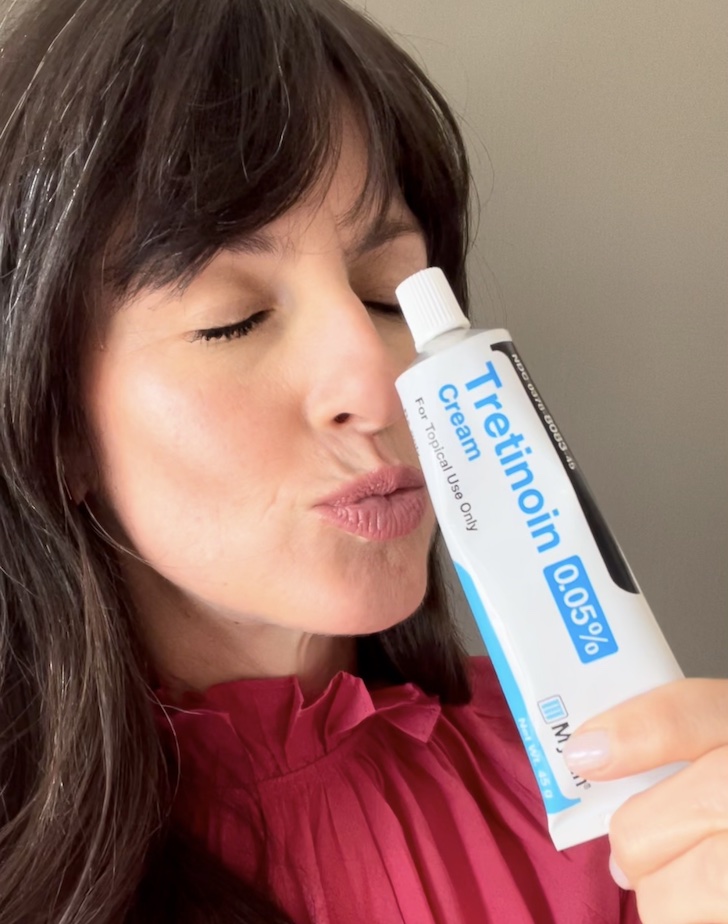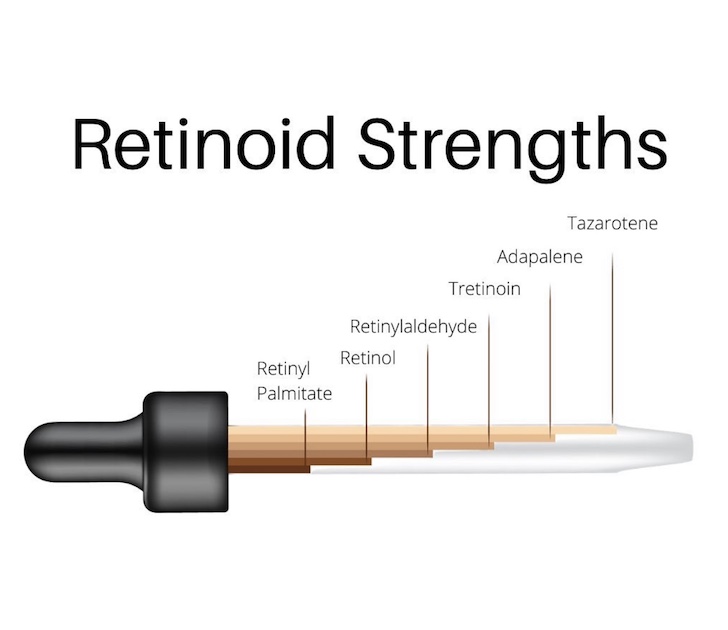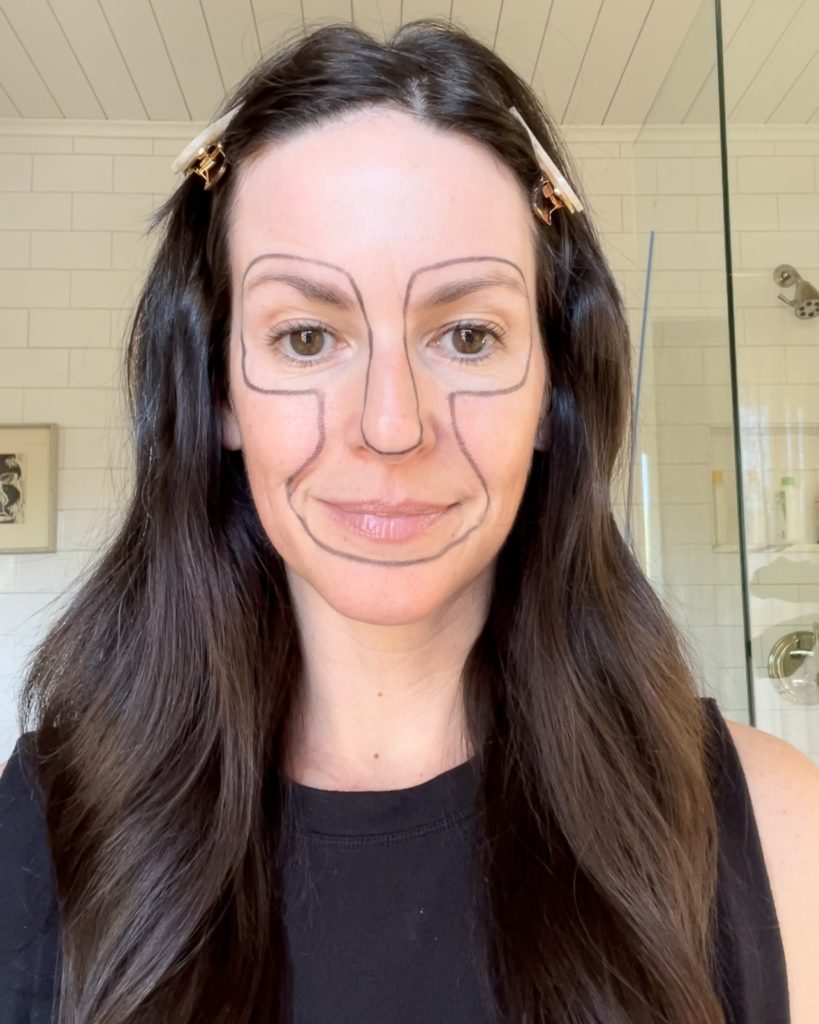
I’ve used over-the-counter retinol products nightly for years (I still believe that this is the best retinol I’ve tried) and they’ve worked absolute wonders for my skin. Honestly, I will be using a retinoid until the day I die, forever and ever amen. However, I recently became super curious about upping my retinoid game to Tretinoin, a prescription-strength retinoic acid.
2023 update: I’m back to using OTC retinol – I prefer a gentler approach to my nightly retinol routine.
Wait wait wait, let’s back up for a second. Retinoids, retinol, retinal, retinoic acid…what does it all mean?! Let me give you a little primer on all things retinoid.
What are retinoids?
Retinoids (which is the umbrella term for most topical vitamin A–based drugs) are the most studied anti-aging compounds, as I’m sure you’ve heard of Retin-A, which was the first retinoid. Originally used as an acne treatment in the 70s, researchers soon discovered that it also evened pigmentation, sped up the turnover of superficial skin cells, and reduced fine lines and wrinkles.
How, you ask? Well, retinoids increase the production of collagen, as well as stimulating the production of new blood vessels in the skin which improves the skin’s overall look. It usually takes about 3 months of regular use to see results, and the best results are usually seen between 6 and 12 months.
There are all different strengths and types of retinoids – prescription formulas usually contain retinoic acid, and nonprescription alternatives (such as retinol) need to be converted into retinoic acid by the skin at the cellular level. Retinol is more gentle than retinoic acid and retinaldehyde falls in between the two, but it’s important to note that the end results are usually the same…it just takes retinol and others longer to achieve the same results as retinoic acid. There are also weaker retinoids such as retinyl palmitate, retinyl acetate, and retinyl linoleate, which are the most gentle.
Here’s a great visual on the differing strengths of retinoids.

image source: 101.skin
BOTTOM LINE – RETINOIC ACID IS THE STRONGEST, BUT ALSO THE MOST IRRITATING. RETINOL is in the middle – NOT AS STRONG AS RETINOIC ACID, BUT STILL IMPROVEs THE APPEARANCE OF SKIN AND is LESS IRRITATING IN THE PROCESS. Most importantly, ALL retinoids will PRODUCE A SIMILAR RESULT, IT JUST TAKES THE WEAKER ONES LONGER.
A note for all my fellow African Botanics Cell Resurrection Serum junkies – if you have been using it for over a year and want to up your game without getting a prescription, I highly recommend trying the African Botanics Retinal Night Cream, which contains 0.1% retinaldehyde and is formulated for more experienced retinoid users.
We good? Okay, moving right along. Now that I’ve been on Tret for a couple of months, I can attest that it is indeed WAY stronger than the retinol serums I’ve used in the past. Where I could jump right in with my OTC retinol serums, a much more careful approach should be taken when using retinoic acid. Here are my tips!
Tips for Using Retinoids
1. GO SLOW
Considering you will probably be using a retinoid for years to come, there’s no reason to rush – especially with Tret or other prescription-strength retinoids. I am still only using Tret 3/week.
As for gentler OTC retinol products (like Cell Resurrection Serum), you can apply much more frequently with no issue. (After an intial testing period, of course.)
I started with Tret 1x/week for a couple of weeks, then bumped it up to 2x/week for a few weeks, and then 3x/week. I experienced minimal redness and peeling while following this schedule.
I personally continue with the African Botanics Cell Resurrection Serum on the nights I do not use Tretinoin. This works fine with my skin, however, it might be different for you. A conversation with your dermatologist would be best to tailor your specific approach.
2. A LITTLE GOES A LONG WAY
A pea-sized amount is all you need for your entire face. A pea-size, you say? How am I going to spread that little of product over my entire face? Well, this is where Dr. Ranella Hirsch has you covered. This primer is super helpful on how to divvy up your retinol.
When applying, you might consider steering clear of the eye area and around the nose and mouth if you are sensitive.
Look! I drew you a face map! #becauseofcourseidid

I do not put Tretinoin inside those markings, which is basically around the eyes, nose, and mouth. The interesting thing about skin absorption is that products don’t penetrate in a perfectly linear line. They spread within the skin, so even though I’m not actively rubbing next to my nose, a little bit of the product is still migrating. (I personally know this as a fact because I experienced peeling around those areas.)
So if you are concerned about fine lines and wrinkles around your eyes and mouth, don’t worry because the product is still reaching those areas.
MOISTURE SANDWICH
Moisturizer + Retinoid + Moisturizer
Retinoids are usually directed to be applied to clean, dry skin and many people use this method with success. However, I have really dehydrated skin that always feels tight after cleansing, so applying Tret on already tight skin and waiting for it to absorb before applying moisturizer was slightly torturous for me.
Never fear! You can apply moisturizer before and after the retinoid – thus making a moisture sandwich. This is also excellent for sensitive skin types because it’s a gentler approach.
I always let my moisturizer sink in before applying the Tretinoin – usually about 10-15 minutes. Currently, my favorite moisturizer for this method is Tata Harper Superkind Fortifying Moisturizer.
SPF IS CRUCIAL
If you are leaving here with one takeaway, let it be this. You simply must use sun protection while using retinoids.
It’s virtually pointless to use a retinoid if you aren’t going to protect your face with SPF. Think about it – many of us are using a retinoid to improve skin issues caused by sun damage, but not wearing SPF just equals more sun damage. You’re basically canceling the two out and wasting your money, plus your skin will be more sensitive to the sun while using a retinoid. So slather up!
You can read about my very favorite sunscreens here.
With these tips, you will likely see a reduction in fine lines and wrinkles, faded age spots, and an overall improvement of the skin’s texture and appearance in 4-12 weeks. Good luck on your retinoid journey!
Other posts you might like:



Meg
May 6, 2021 at 10:20 amHi Sarah, I’ve been reading Whoorl for a long time, and it seems like you have had a shift if your approach to ‘green’ products/beauty. I think it’s refreshing because things and people change, and it’s normal. As a longtime reader, I would love to hear how your thoughts have evolved/are evolving.
whoorl
May 6, 2021 at 11:50 amHey Meg! I’m trying to figure out how to make my thoughts concise for this comment, so the short story is that I LOVE clean beauty but not because I fear conventional beauty.
Longer story…I really started thinking about this more during the pandemic, especially in terms of vaccine information. I found myself listening to scientists and physicians and trusting vetted scientific data (“vetted” being the operative word) when on the flip side, I was letting marketing terms and buzz words lead me to make purchases without that same reasoning. A perfect example is Tretinoin. Tret is probably the most studied skincare product in history. It has decades of safety and efficacy data. Do we have that kind of data for some of these newer clean ingredients? It’s something to ponder…at least that’s how I feel.
Truth be told, “clean beauty” is a marketing term and I definitely bought into a lot of the fear-mongering rhetoric (Toxic! Unsafe! Europe bans 1300 ingredients and US only 11! Beauty is making us sick!), but then I started listening to scientists, dermatologists, and cosmetic chemists and educating myself on things like the importance of formulation and how “the dose makes the poison,” etc. I have come to realize there is SO MUCH nuance when it comes to the beauty industry. Bottom line, I don’t think conventional beauty is going to kill us. I guess you could call me a beauty moderate – I think people should do what works for them, depending on their needs, beliefs, and budget.
With that being said, I looooove clean beauty brands and have met some of the most incredible founders who put so much thought into their formulations. I love how many clean beauty brands are women-owned small businesses that focus on our planet and their customer always comes first. So, I will absolutely continue to predominantly use clean beauty products, but won’t be afraid to use conventional ones either. Hope this helps!!
Meg
May 6, 2021 at 3:44 pmThis makes so much sense and brings us through your thought process so thoroughly. And also go science! Thanks for sharing.
Jane
May 7, 2021 at 9:23 amVery thoughtful and appreciated response.
Sarah Cunningham
May 13, 2021 at 1:24 pmI love how thoughtful and kindly this is written. Explains why I’ve been a fan of you social presence for (ahem) years. Thanks…
SB
May 6, 2021 at 4:12 pmGreat answer to above question- I had wondered the same thing, and that makes perfect sense. I feel relieved not feeling “guilty” when choosing to mix clean beauty with other choices. Thanks
Missy Simones
May 7, 2021 at 12:24 pmHaha, thank you for the map! I have been trying to use African Botanics Cell Resurrection Serum for a few months and I totally react around my nose. I have never reacted to any skin product before. So I am steering clear of that area and only using a few times a week. I am clearly not ready for anything stronger! Thanks for this info!
whoorl
May 7, 2021 at 1:13 pmGlad you are able to tolerate the Cell Resurrection on the other areas of your face!
Angie
May 7, 2021 at 1:14 pmThank you for this! Have you tried the Maya Chia Straight A Retinol Treatment, and if so, any thoughts on how it compares with the African Botanics serum? Thanks!
whoorl
May 7, 2021 at 1:18 pmI personally prefer water-based serums (I like the gel-like texture) and Straight A is an oil-based one, so that’s why I don’t reach for it. People love it though!
Angie
May 7, 2021 at 4:52 pmThank you – very helpful!
natasha
May 11, 2021 at 7:53 amWould you recommend including it in your AM or PM skincare routine?
whoorl
May 11, 2021 at 8:30 amRetinoids should only be used a night and sunscreen during the day is a must.